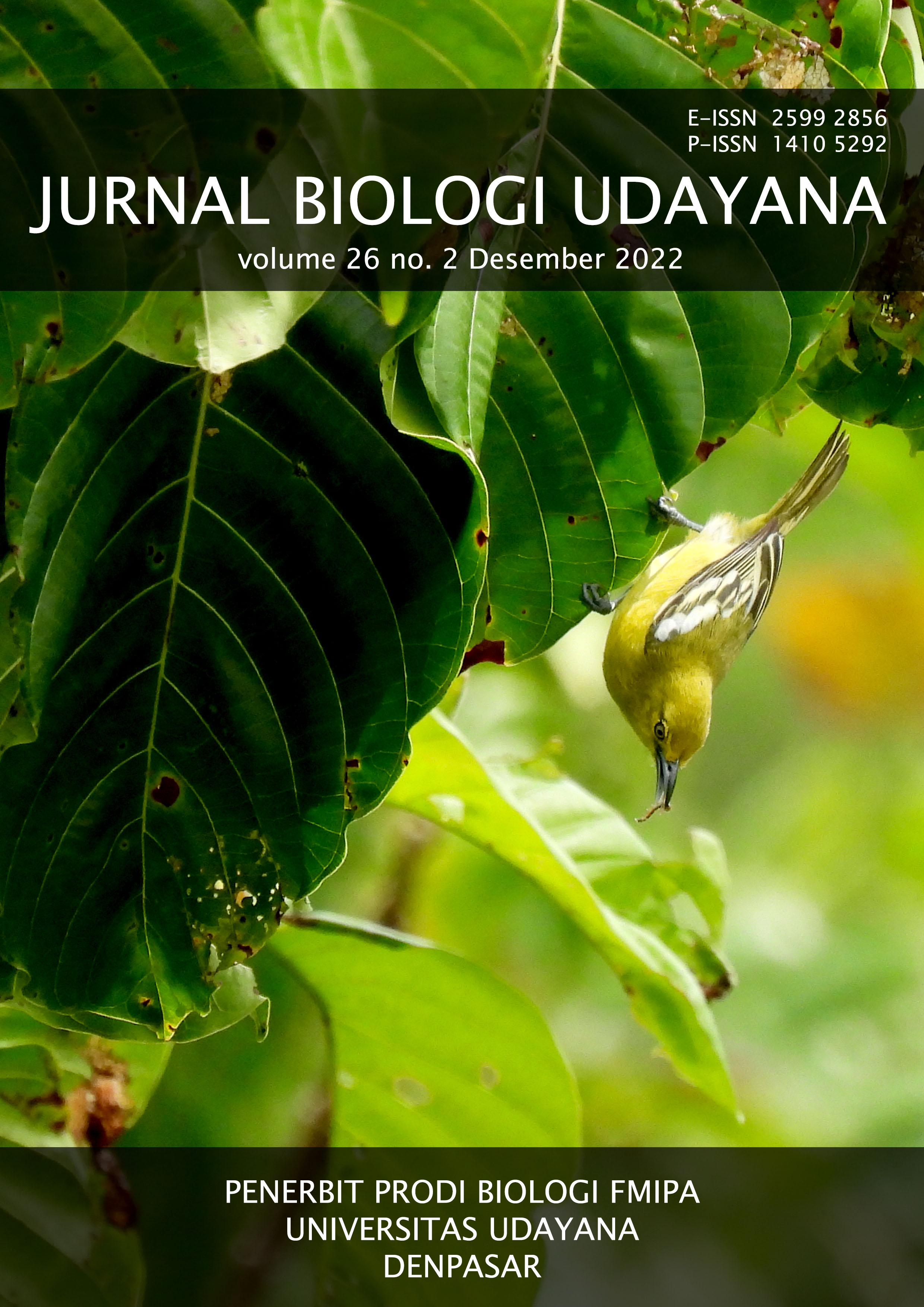Effectiveness of n-hexane and ethanol extract of papaya (Carica papaya L.) leaves as shallot pest (Spodoptera exigua Hübner) natural insecticide
Abstrak
One of the agricultural commodities that has a high selling value and consumption level is shallot (Alium ascalonicum). However, the productivity of shallots is known to be susceptible to plant-destroying organisms, such as the shallot caterpillar (Spodoptera exigua). Currently, most shallot farmers control S. exigua using synthetic insecticides. Synthetic insecticides are poisonous and use for a long time period will cause resistance to pests and environmental pollution. One of the natural ingredients that has the potential as a botanical insecticide is papaya (Carica papaya). This study aimed to determine the effectiveness and concentration of n-hexane and ethanolic extracts of papaya leaves which are the most effective against toxicity and inhibition of the feeding power of S. exigua second instar larvae. The extract was obtained by gradual maceration of n-hexane (non polar) and ethanol (polar) solvents. Test the secondary metabolite content of papaya leaves using Thin Layer Chromatography (TLC). The results showed that the ethanol extract was the most effective extract in causing toxicity to larvae with the highest percentage of 96.67%. Meanwhile, n-hexane extract was more effective in inhibiting larval feeding than ethanol extract with the lowest feeding area of 2,27 mm. The most effective concentration of against toxicity and feeding inhibition of larvae is concentration 3%. The LC50 value of the ethanol extract was 0.0207% and the n-hexane extract was 0.0459%. Both extracts are known to contain compound groups, namely tannins, terpenoids, flavonoids, and alkaloids.
##plugins.generic.usageStats.downloads##
Referensi
Dinas Pertanian DIY. 2012. Standard Operating Procedure (SOP) Bawang Merah Gunungkidul. Dinas Pertanian DIY: Yogyakarta.
Eleazu CO, Eleazu KC, Chukwuma SC. 2012. Comparative Study of The Phytochemical Composition of The Leaves of Five Nigerian Medical Plants. Journal of Biotechnology and Pharmaceutical Research 3(2): 42- 46.
Hasfita F, Nasrul ZA, Lafyati. 2013. Pemanfaatan Daun Pepaya (Carica papaya) untuk Pembuatan Pestisida Nabati. Jurnal Teknologi Kimia Unimal 1(2): 13-24.
Isman, M. 2002. Insect Antifeedant. Pesticide Outlook. 6: 234-279.
Marhaen L, Aprianto SF, Hasyim A, Lukman L. 2016. Potensi Campuran Spodoptera exigua Nucleopolyhedrovirus (SeNPV) dengan Insektisida Botani untuk Meningkatkan Mortalitas Ulat Bawang Spodoptera exigua (Hübner) (Lepidoptera: Noctuidae) di Laboratorium. J. Hortikultura 26 (1): 103-112.
Nengsih R, Utami LB. 2019. Pengendalian Ulat Grayak Bawang Merah (S. exigua) Menggunakan Ekstrak Metanol 70% Daun Pepaya (Carica papaya) dan Ekstrak Etanol 70% Umbi Gadung (Dioscorea hispida). J. Ilmu Alam dan Tek Terapan 1: 12-22.
Purrington CB. 2003. Secondary Products: Antifeedant Substances in Plants. Encyclopedia of Applied Plant Sciences. 1140-1145
Rahayu SE, Leksono AS, Gama ZP, Tarno H. 2020. The Active Compounds Composition and Antifeedant Activity of Leaf Extract of Two Cultivar Carica papaya L. on Spodoptera litura F. Larvae. AIP Conference Proceedings (1): 2231.
Rahman A, Samharinto S, Salamiah. 2020. Mortalitas Ulat Grayak (Spodoptera litura F.) yang Diaplikasi dengan Berbagai Pestisida Nabati. Proteksi Tanaman Tropika 3(03): 238-243.
Savitri ES, Holil K, Resmisari RS, Syarifah U, Munawaroh S. 2019. Effect of Extraction Solvent on Total Phenol, Total Flavonoid Content and Antioxidant Activities of Extract Plant Punica granatum, Vitis vinifera L., Ficus carica L. and Olea europea. AIP Conference Proceedings.
Sharma A, Kumar V, Shahzad B, Tanveer B, Sidhu GPS, Handa H, Kohli SK, YadaV P, Bali AS, Parihar, Dar OI, Singh K, Jastoria S, Bakshi P, Ramakrishnan M, Kumar S, R. Bhardwaj R, Ashwani, Thukral K. 2019. World Pesticide Usage and its Impacts on Ecosystem. SN Applied Sciences 1(11): 1446-1485.
Simmonds MSJ, Stevenson PC. 2001. Effects of Isoflavonoids from Cicer on larvae of Heliocoverpa armigera. J. Chem. Ecol 27(5): 265-277.
Smagghe G, Pineda S, Carton B, del Estal P. 2003. Toxicity and kinetics of methoxyfenozide in greenhous selected Spodoptera exigua (Lepidoptera: Noctuidae). Pest Manage. Sci. 59: 1203–1209.
Tarigan A, Sumarmi S, Sukirno. 2020. Effectiveness of Aloe (Aloe vera L.) as a Protectant of Bacillus thuringiensis var kurstaki Againts Ultraviolet Light and Biological Control Agenst of (Spodoptera litura Fab.). AIP Conference Proceedings.
Udiatro BK, Setiawan W, Suryaningsih E. 2005. Pengenalan Hama dan Penyakit pada Tanaman Bawang Merah dan Pengendaliannya. Panduan Teknis PPT bawang merah No. 2. Balai Tanaman Sayuran: Bandung.
Vien DTH, Loc TV. 2017. Extraction and Quantification of Carpaine from Carica papaya Leaves of Vietnam. International Journal of Environment, Agriculture and Biotechnology (IJEAB) 2(5): 2394-2397.
War AR, Paulraj MG, Ahmad T, Buhroo AA, Hussain B, Ignacimuthu S, Sharma HC. 2012. Mechanims of Defense againts Insect Herbivores. Plant Signaling & Behavior 7(10): 1306-1320.
Wijaya IN, Wirawan IGP, Adiartayasa W. 2018. Uji Efektivitas Beberapa Konsentrasi Ekstrak Daun Kirinyuh (Chromolaena odorata L.) terhadap Perkembangan Ulat Krop Kubis (Crocidolomia pavonana F.). Agrotrop 8(1): 11-19.



